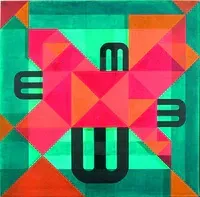First public exhibition since 1979 for Guy Ngan

Courtesy Dominion Post, Friday August 4 2006
by Mark Amery
Fashion is inconstant as to where its loyalties lie in relation to the past. There's no better example of this than our view of the international modernist style that dominated architecture and design in the 1950s and 60s. You know: think patterns of abstract interlocking geometric and organic shapes. Think a search for truth in materials - most notably concrete.
Image: Tiki Hands Encompassing Immense Space (1978 - 2002) by Guy NganCourtesy Dominion Post, Friday August 4 2006
by Mark Amery
Fashion is inconstant as to where its loyalties lie in relation to the past. There's no better example of this than our view of the international modernist style that dominated architecture and design in the 1950s and 60s. You know: think patterns of abstract interlocking geometric and organic shapes. Think a search for truth in materials - most notably concrete.
Image: Tiki Hands Encompassing Immense Space (1978 - 2002) by Guy NganEvoked for many people are strong competing feelings of nostalgia and ambivalence. Not surprising, given how we feel about the values of recent generations' past and given this particular style's ubiquity due to the corresponding post-war growth of our cities and suburbia.
The imprint of this era is often evident in the building blocks of the work of a generation of visual artists who studied in the 1950s (and often both art and design back then). While some artists of this generation have transcended this dominant fashion to forge utterly distinct practises, there are others whose work decades later still evokes a distinct era.
Wellington artist and designer Guy Ngan is one. It explains in part why the work of this interesting senior artist has not received much critical attention. It's also explained in part by the fact that Ngan's public output has primarily been in the provision of outdoor friezes, murals and sculptures at a time when public works programmes were considered construction and art was something you saw inside in a museum. Ngan's biography in the catalogue City Gallery exhibition Journey: Aluminium Panel, Tiki Hands and Anchor Stones is interesting for the length of the list of public commissions next to the absence of a record of exhibitions.
This exhibition, the first by new City Gallery Senior Curator Heather Galbraith and Ngan's first public exhibition of his work since 1979, provides a smart way into reappraising an artist the gallery rightly champions as overlooked. By focusing on some strong interconnecting themes in Ngan's work it draws out strong conceptual layers in Ngan's work that in a larger retrospective might have been less apparent. It draws together work with a strong interest in the stamp of identity and the importance of journey, and this Chinese New Zealander's related longstanding interest in early Pacific navigation and own history as both a traveller and person rooted both here and in Asia.
Implicit is the suggestion that issues with the style of Ngan's work have seen us overlook consideration of some of its distinctive content. It's also suggested that our contemporary more pluralistic approach to style, our receptiveness again to artists working across the disciplines of art and design, and our heightened appreciation of the conceptual ideas underpinning work mean we should be prepared to reappraise the contribution of some artists.
This all said, don't expect any new space for Ngan to be made in the canon. His work is significant but lacks the distinct identity of some of the key figures of his generation. As evidenced here by a mural formerly outside Auckland's Newton Post Office Ngan produced some terrific public work, but not all like this mural are so timeless. I found the painting in the exhibition something of a mixed bag. While a work like Oceania No.6 is quite a revelation, others lack a final shimmer, lustre or mystery to involve us beyond their strong conceptual and aesthetic ideas. Yet given Ngan is now 80 and was 45 when he first started these paintings, their freshness and verve is quite remarkable.
What's sure is the strength and interest of Ngan's ideas, revealed beautifully by this exhibition's tight intelligent curation. A key motif in the paintings are the 'Tiki Hands', which at once reference the three fingered hand seen in Maori carving, the three front claws of the travelling seabird that Ngan believed inspired the early explorers, and the traditional Chinese name stamp. In a series of works this motif can be seen in a process of agitated movement navigating the picture plane, propagating descendents and making their mark on established ground.
I very much like Ngan's 'Anchor Stone' sculptures from the early 1990s, a selection placed centrally to anchor the exhibition. Their compact play with the fluidity of form and volume feels of an earlier time (the work of Barbara Hepworth and Henry Moore, and Tanya Ashken's 'Albatross' sculpture down on Frank Kitts Lagoon), yet they're not only accomplished and engaging in the abstract but also rich in their evocations.
Inspired by Kupe's anchor stone Maungaroa and as if worn through by the wear of rope and flow of the ocean, they represent the explorer who has found grounding in a particular time and place. I'm reminded of the Tiki Hand and the name stamp but also of the clasp of fingers and thumb- the action of making human connections and gripping to pull a rope or hold instrument in the construction of things. It's a gesture full of a hope in what humans can achieve as a community through technical progress, be it in navigation of the Pacific or the building of cities.
Journey: Aluminium Panel, Tiki Hands and Anchor Stones, Guy Ngan, City Gallery Wellington, until 24 September.
www.citygallery.org.nz